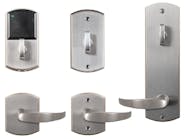The 2011 Hyundai Sonata uses the new Hyundai high-security four-track lock system. All Hyundai high-security lock systems are based on the older Lexus system. The Hyundai system has 12 cuts, with six cuts located on each side of the key. All of the tumblers are “split tumblers” with six separate tumblers riding on each side of the key. A mechanical key for all of these lock systems can be made on the Ilco LXP90 key blank.
Unlocking the Sonata
Like most new vehicles, the 2011 Sonata uses bicycle-style cables inside the doors, eliminating the possibility of using a tool that goes inside the door cavity to unlock the car. A long-reach tool such as the “Jiffy-Jak Vehicle Entry System” can also be used on the Sonata, but I prefer to use an under-the-window style tool such as the Tech-Train 1025. The fit at the base of the window on the Sonata is not nearly as tight as on a lot of other cars so it’s relatively easy to get an under-window tool in and out.
I use two wedges inserted about 10 inches apart, and centered above the inside door handle in order to make room to insert the tool. Because of the multi-layer weather stripping, I always insert a plastic shim between the glass and the weather stripping before I insert the wedges. The shim will prevent the wedge from rolling the lower layer of the weather stripping under as you insert it. Once the wedge is in place, the shim can be removed.
I use the shim once again as I insert the tool, so that it also doesn’t roll the lower layer of the weather stripping under. If you allow the weather stripping to roll under the wedge or the tool, it will make it harder to move the tool once you insert it into the door, and it may even damage the weather stripping.
When the top bend of the tool is below the bottom edge of the glass, stop and remove the wedges. This will make it easier to manipulate the tool in the door, and it will reduce the stress on the glass. If you don’t remove the wedges, you run a risk of breaking the glass. In addition, if the vehicle is equipped with after-market tint film on the window, you are much more likely to damage the film if you don’t remove the wedges.
Once the tool is free to move inside the passenger compartment, bring the tip of the tool down to the inside lock control rocker. Use leverage against the handle end of the tool to flip the rocker to the rear and unlock the door. Once the door is unlocked, using the shim again on the inside of the door will help protect the inside weather stripping, and make it easier to remove the tool from the door.
Door Lock
The door lock is the easiest lock on the car to remove and it also has all of the tumblers in order make a key that will work the entire car. The lock is held in place with a single 8mm bolt concealed behind a plastic plug on the edge of the door.
Unlike many vehicles, the bolt that holds the door lock in place is not captive and will come completely free of the door. Do not drop it inside the door as you remove it. A magnetic insert in your socket or nut-driver will keep the bolt from falling.
After the retaining bolt has been removed, the lock will pull out of the door. You may have to pull the handle slightly in order to free up the lock. There is no code on the door lock, but it can be decoded easily.
Once the lock is free of the door, take it into your shop or truck to decode it. The lock assembly consists of the lock, tailpiece, and a plastic shell that matches the paint color. Use caution as you work on the lock to avoid scratching the plastic shell.
A large drain hole on the underside of the lock will allow you to sight-read ten of the 12 wafer tumblers. If you have a set of depth keys, sometimes referred to as “guide keys,” for this lock system, you can insert them one at a time to help you sight-read the depths of the cuts. After you have decoded the cuts that you can see, use a fill program or progression to determine the remaining two cuts.
The tailpiece is held in place on the back of the lock plug with an E-ring that you can pry free easily. There is also a roll-pin in the tailpiece, but this does not have to be removed in order to release the tailpiece. Once the tailpiece has been released from the lock, you will see the coiled return spring wound around the end of the lock plug. Take careful note of how this spring is mounted before you pull it out, so that you can replace it properly when you reassemble the lock.
The plastic shell is snapped over a small tab on the side of the lock housing. Remove the shell by carefully prying it over the end of the tab. Be especially careful in very cold weather to avoid cracking the plastic shell. After the plastic shell is free, you can access the facecap of the lock. Be sure to keep the plastic shell in a safe place so that it does not get damaged while you are working on the rest of the lock.
The facecap is reusable if you treat it gently. Carefully work your way around the facecap with a small screwdriver until the facecap comes free of the lock. Be patient as you do this, one edge of the cap actually curls under and into a slot in the housing and you will have to work it out a little at a time if you want to be able to reuse the facecap.
After the facecap is out of the way, slide the plug out of the housing. The shutter assembly can be left in place, but be aware that it is not held in place very tightly. It may fall out as you service the lock, so you may want to remove it just to make sure that you don’t lose any of the parts. If you decide to remove the shutter assembly, lift it carefully free of the plug and be ready to catch the shutter door and the spring that keeps the shutter closed.
The shutter assembly consists of three parts: the cover, shutter, and spring. Put these parts aside so that you don’t lose them while servicing the lock. I use a magnetic parts tray to keep track of small parts like these.
With the plug removed, you can now decode the lock either by removing the tumblers or by sight reading. There are 12 tumblers in the lock, mounted in pairs as “split tumblers,” with each pair facing in the opposite direction from the tumbler pair in the next chamber. If you choose to remove the tumblers, make sure that you don’t lose or damage the springs. Also make sure that you keep the tumblers in their correct order so that you can properly decode the lock.
Each of the tumblers is stamped with its corresponding depth. However, as is the case with many high-security lock systems, the numbers stamped on the tumblers are the opposite of the depths as we use them here in North America. The deepest depth in the system is a number four depth and those tumblers will be stamped with a “one.” The shallowest depth is the number one depth, and those tumblers will be stamped with a “four.” On this particular vehicle, there were no number one depths used, so in the photo you will only see tumblers stamped “one,” “two,” and “three,” which correspond to depths four, three, and two.
Inside the lock housing is a separate chamber for each of the four groups of tumblers. If you choose to pick the lock, as soon as the plug turns slightly, two sets of tumblers will drop into the wrong chambers, locking the plug in the slightly turned position. This is the problem in picking most locks that are equipped with split-tumblers. If you choose to use a picking tool, such as the Lishi 2-in-1 pick and decoder, you will have to pick the lock three times. The first time it is picked, it will only turn slightly until half the tumblers drop into the wrong chambers. Next, you will have to pick the lock out of this position to get it to turn completely, so that you can decode the lock. After you have decoded the lock, it will once again hang up in the wrong position as you turn it back. You will have to pick it once more to get it back to the normal position where a key can be inserted.
Trunk Lock
The trunk lock is not quite as easy to remove as the door lock, but it’s still fairly simple. The trunk lid is lined with a fitted trim panel that is held in place with a series of plastic upholstery fasteners around the outside edge. Each fastener is slotted for a Phillips head screwdriver, but when you unscrew the fastener, it will only back out about a quarter of an inch, and then stop. At that point, grab the head of the fastener and pull it free. When you replace the fastener, push in on the head in order to lock it back into place.
An emergency release handle is located on the underside of the trunk lid trim and has to be removed before the trim will come free. The top of the handle has a plastic cover with a small slot located below the word “Pull.” Insert a small screwdriver into this slot and pry carefully to release the top of the cover to expose two mounting screws. After these two screws have been removed, the inner trim on the trunk lid will come free.
Once the trim has been removed, you will have free access to the trunk lock. The lock itself is secured to the trunk lid with two 10mm bolts. A bicycle style cable also connects the lock to the inside trunk release handle. After the two bolts and the cable have been released, the trunk lock will pull out easily.
When the lock has been removed from the vehicle, it can be disassembled and decoded. The tailpiece is held onto the rear of the plug with an E-clip like the one that was used on the door lock. Directly below the tailpiece is the return spring. As you remove the return spring, make sure that you take note of how it was wound around the end of the plug so you can replace it properly when you reassemble the lock. Once the facecap is out of the way, the lock plug will slide out of the housing easily. When the plug is free of the housing, you can decode it or rekey it just like the door lock.
Ignition Lock
The ignition lock is the hardest lock on the car to remove, and I do not recommend taking this lock out unless you absolutely have to. Hyundai designed the steering column shroud in such a way that the steering wheel must be removed in order to access any of the components inside the column. This means that you must disarm and remove the airbag before you can even see the lock retainer.
The first step in disarming the airbag is to disconnect the negative terminal of the battery. Whenever you disconnect a battery, always begin by disconnect the negative terminal. This is done for safety reasons. If you slip with your wrench and make contact with the body of the vehicle while you are disconnecting the negative terminal, you will not short out the battery like you would if you were disconnecting the positive terminal. Once the negative terminal has been disconnected and the cable isolated from the battery terminal, it will be safe to work on the airbag.
The airbag is held in place with three spring-loaded quick-release fittings. The springs allow the airbag module to move up and down slightly so that pressing in on the airbag module will blow the horn. There are three small holes located on the underside of the steering column, one at each corner of the triangular shaped airbag module. To release the airbag, insert a probe into each one of the holes in turn and press in on the small retainer at the end of the fitting. As you do this, the corners of the airbag module will pop out slightly.
After you have released all three corners of the airbag, it will come free of the steering wheel, and you will be able to see the ends of each fastener. The retainer that you depressed to release the fitting is located near the end of the shaft, and protrudes perpendicularly from the shaft. When you replace the airbag module, position each shaft inside its socket and then press down on the airbag. The three fasteners will lock back into position automatically when the airbag module is properly seated.
Two electrical cables are attached to the back of the airbag module. Each fitting uses a safety connection that automatically shorts the pins inside the connector as it is removed. This prevents any possibility of static electricity damaging or deploying the airbag. Each cable has a locking device that must be gently pulled up before the cable can be disconnected. In addition, each connector is color-coded to make the reassembly easier and safer.
After the cables have been disconnected, the airbag module can be removed and stored in a safe place while you service the ignition lock. When handling any airbag module, always keep your fingers and any small objects away from the electrical connections. In addition, when setting the airbag aside, always set it down with the upholstered side up.
After the airbag and the 22mm steering wheel nut have been removed, use a steering wheel puller in the normal fashion to remove the steering wheel. This will expose the two screws that secure the lower portion of the steering column shroud that were hidden by the steering wheel. The upper portion of the shroud clips into the lower portion and it can be lifted free simply by pulling up on it. The lower portion of the shroud is secured with the two screws in the front and one additional screw from below the column.
After the lower portion of the shroud has been removed, the ignition lock will be exposed. Two small screws hold the lighted ring on at the face of the ignition lock. After the lighted ring has been removed, you will be ready to remove the ignition lock. The active retainer is now visible on the side of the lock housing that faces the driver. Once the lock has been turned to the “ON” position, the retainer can be depressed and the lock removed from the column.
Just as on the older Hyundai ignitions, a rubber plug holds the two portions of the housing together. Removing this plug will allow you to separate the lock assembly from the shell that surrounds it. A second rubber plug locks the face portion of the housing in place, and once it has been removed the facecap can be rotated and removed.
The last step in disassembling the ignition lock is to remove the snap-ring at the rear of the lock plug. With the snap-ring removed, the lock plug will slide out of the housing easily for service. The ignition lock, just as the door and trunk, contains all 12 of the tumblers.
There was no transponder programming necessary on this vehicle because it was not transponder equipped. As a general rule, very few Hyundai vehicles sold in the U.S. are transponder equipped. So far, the only 2011 Sonata that I have seen that was equipped with a transponder also had a dealer prox system that included a push-button start.





